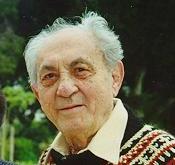 Myrim
Baram
Myrim
Baram
Kibbutz Kfar Menahem
ISRAEL
Back to Start Page
Our younger son, Gabriel Baram (Gavri),
was killed in his Patton tank on the shores of the Suez Canal, on the first
day of the Yom Kippur War, October 1973. It was only months thereafter
that we learned what had happened to him.
During those long nights when I
had failed to find escape in sleep, I was constantly seized by the oppressive
fear that my son would remain an unknown soldier and disappear into oblivion.
I felt the need to do something so that he would remain more than that.
Gavri was born on Hannuka, the
Festival of Lights, in Kibbutz Kfar Menahem. As a child he liked to hear
me tell stories of my childhood experiences in Lithuania, my East European
home, and stories from the bible and Jewish history. Of all the biblical
and traditional stories that I told him, the Hannuka tales fired his imagination
the most. There were also times when he would join me in my blacksmith
shop and there I taught him the skills of welding and soldering. To practice
we once created a hannukia together where the notes of the popular Hannuka
song "Maoz tzur" are prevalent.
While recalling those wonderful
moments with Gavri and how much light and love he brought to his mother,
Rozka, myself and to those around him, the thought occurred to me that
an appropriate memorial to him would be the creation of a number of hannukias.
The first ones that I did were
of the traditional style like those lingering in my mind from my family
home in Europe. I used traditional Jewish motifs and symbols including
Torah crowns, scrolls and the seven varieties of agricultural products
of ancient Israel. I also incorporated illustrations from holy books, Passover
Hagadas, and old Jewish manuscripts.
I was commissioned to create larger
hannukias by Beit Hahayal (The Soldiers Home) in Tel-Aviv, by the regional
Museum at Kfar Menahem and by Yad Labanim (The
Soldiers Memorial House) in Petah-Tikva.
These are designed around the words
"Gabriel", "Hannuka", and "Tashnav", respectively. All three serve to inspire
creativity among the school children visiting these establishments and
I continued to use these themes in other, smaller, hannukias.
When Gavri became Bar Mitzvah,
his mother and I took him to Jerusalem for a week and we crisscrossed the
city on foot. He was deeply moved as he came face to face with Jewish history.
Two of the hannukias are reminiscent of those days with Jerusalem
as their main theme.
Gavri became a very proficient
handball player and as such was sent to the Olympic games in Munich in
1972 as part of the Israeli youth delegation. There, eleven Israeli athletes
were murdered. This tragedy affected him very deeply. One hannukia recalls
this event in his life.
Time went on and I continued to
create hannukias in Gavri's memory. They dealt with themes of war (fire,
flames, weapons) and a yearning for peace (doves, the word "shalom", the
olive branch).
I have used quotations from the
prophets as well as past and present Jewish writers for inspiration.
Isaiah's vision of swords
turning into plowshares was always on my mind.
Each hannukia includes a dedication,
in Hebrew, to Gabriel. The text reads: "In memory of our dear Gavri who
was born on Hannuka 5716 and fell in the Yom Kippur War 5734". (Wherever
a Hebrew text on the hannukia has not been explained in the description
it is this dedication).
Gavri was 18 years 9 months
and 10 days old when he fell. His tank and crew were found in the sand
dunes on the eastern banks of the Suez Canal by army search teams, six
months after the end of the war.
A watch in the tank had stopped
at 21:45 on the night of Yom Kippur. At that very hour time stopped for
our Gavri of blessed memory. In one hannukia I have expressed those two
fateful years of his birth and death as the beginning and the end of a
life cycle.
 Myrim
Baram
Myrim
Baram
Kibbutz Kfar Menahem
ISRAEL
![]()
Back to Start Page
e-mail us